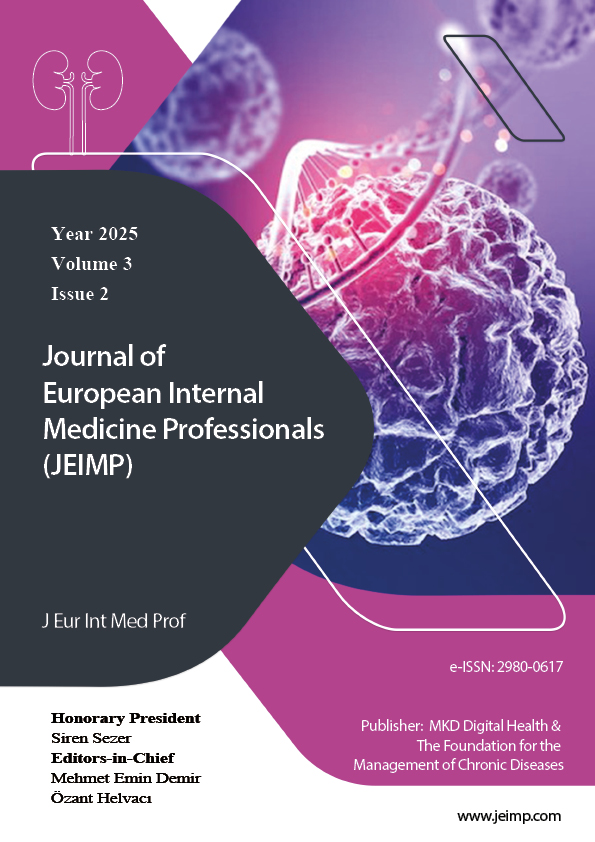Pain-related Factors in Hemodialysis Patients
Pain in Hemodialysis Patients
DOI:
https://doi.org/10.5281/zenodo.15047753Keywords:
Hemodialysis, Pain, Quality of Life, SleepAbstract
Background: Pain is a prevalent issue among patients undergoing hemodialysis (HD). This study aimed to evaluate the prevalence of pain and identify factors associated with pain in HD patients.
Methods: Two hundred two HD patients participated in the study. Demographic and clinical data, pain characteristics, and sleep quality were recorded. Symptom burden and pain severity were assessed using the Edmonton Symptom Assessment Scale (ESAS) and the McGill-Melzack Pain (MGP) questionnaire.
Results: The majority of participants were male (59.9%), with a mean age of 59.6±12.7 years. Pain was reported by 80.2% of the patients and was significantly more prevalent among females (p=0.001) and individuals with lower educational levels (p=0.005). Median ESAS and MGP scores were 20 (range: 4-84) and 47 (range: 22-84), respectively. Patients reporting pain had significantly higher levels of CRP (p=0.044), parathyroid hormone (p=0.005), and higher ESAS scores (p=0.001). Sleep quality was impaired in 37% of patients. ESAS scores were significantly higher among females (p=0.003), those with impaired sleep quality (p<0.001), and regular analgesic users (p=0.002). MGP scores were significantly elevated in patients with diabetes (p=0.002), lower educational attainment (p=0.022), daily pain occurrence (p<0.001), and poor sleep quality (p<0.001). Additionally, patients with pain in multiple body regions reported higher MGP scores (p<0.001). There was a significant correlation between MGP scores, age (p=0.001), and ESAS scores (p<0.001).
Conclusion: Pain is highly prevalent among HD patients and is associated with female gender, lower educational level, elevated CRP, and higher parathyroid hormone levels. The severity of pain is particularly influenced by diabetes, low education level, and the number of painful body regions. Moreover, pain significantly impacts symptom burden and sleep quality.
References
Murtagh FE, Addington-Hall J, Higginson IJ. The prevalence of symptoms in end-stage renal disease: a systematic review. Adv Chronic Kidney Dis. 2007 Jan;14(1):82-99. doi: 10.1053/j.ackd.2006.10.001.
Davison SN. Pain in hemodialysis patients: prevalence, cause, severity, and management. Am J Kidney Dis. 2003 Dec;42(6):1239-1247. doi: 10.1053/j.ajkd.2003.08.025.
Gamondi C, Galli N, Schönholzer C, et al. Frequency and severity of pain and symptom distress among patients with chronic kidney disease receiving dialysis. Swiss Med Wkly. 2013 Feb 22;143: w13750. doi: 10.4414/smw.2013.13750.
Patel SS. Treating pain to improve quality of life in end-stage renal disease. Semin Dial. 2013 May-Jun;26(3):268-273. doi: 10.1111/sdi.12066. Epub 2013 Feb 22.
Cohen SD, Patel SS, Khetpal P, Peterson RA, Kimmel PL. Pain, sleep disturbance, and quality of life in patients with chronic kidney disease. Clin J Am Soc Nephrol. 2007 Sep;2(5):919-925. doi: 10.2215/CJN.00820207.
Koncicki HM, Unruh M, Schell JO. Pain Management in CKD: A Guide for Nephrology Providers. Am J Kidney Dis. 2017 Mar;69(3):451-460. doi: 10.1053/j.ajkd.2016.08.039. Epub 2016 Nov 20.
Harris TJ, Nazir R, Khetpal P, et al. Pain, sleep disturbance and survival in hemodialysis patients. Nephrol Dial Transplant. 2012 Feb;27(2):758-765. doi: 10.1093/ndt/gfr355. Epub 2011 Jul 18.
Sadigova E, Ozkurt S, Yalcin AU. Pain Assessment in Hemodialysis Patients. Cureus. 2020 Feb 6;12(2):e6903. doi: 10.7759/cureus.6903.
Oksüz E, Malhan S, Tulunay FC. Turkish McGill Pain Questionnaire: reliability and validation. Value in Health. 2007; 10(6):A467.
Carreon M, Fried LF, Palevsky PM, Kimmel PL, Arnold RM, Weisbord SD. Clinical correlates and treatment of bone/joint pain and difficulty with sexual arousal in patients on maintenance hemodialysis. Hemodial Int. 2008 Apr;12(2):268-274. doi: 10.1111/j.1542-4758.2008.00264.x.
Er MS, Eroǧlu M, Altinel EC, Altinel L. Hemodialysis and pain. Turkish J Nephrol 2013; 22: 167-170.
Fleishman TT, Dreiher J, Shvartzman P. Pain in Maintenance Hemodialysis Patients: A Multicenter Study. J Pain Symptom Manage. 2018 Aug;56(2):178-184. doi: 10.1016/j.jpainsymman.2018.05.008. Epub 2018 Jun 20.
Walker S, Fine A, Kryger MH. Sleep complaints are common in a dialysis unit. Am J Kidney Dis. 1995 Nov;26(5):751-756. doi: 10.1016/0272-6386(95)90438-7.
Brekke FB, Amro A, Hortemo Østhus TB, Dammen T, Waldum B, Os I. Sleep complaints, depression and quality of life in Norwegian dialysis patients. Clin Nephrol. 2013 Aug;80(2):88-97. doi: 10.5414/CN107916.
Harrison L, Wilson S, Heron J, Stannard C, Munafò MR. Exploring the associations shared by mood, pain-related attention and pain outcomes related to sleep disturbance in a chronic pain sample. Psychol Health. 2016 May;31(5):565-577. doi: 10.1080/08870446.2015.1124106. Epub 2016 Jan 2.
Samoudi AF, Marzouq MK, Samara AM, Zyoud SH, Al-Jabi SW. The impact of pain on the quality of life of patients with end-stage renal disease undergoing hemodialysis: a multicenter cross-sectional study from Palestine. Health Qual Life Outcomes. 2021 Feb 2;19(1):39. doi: 10.1186/s12955-021-01686-z.
Berkley KJ. Sex differences in pain. Behav Brain Sci. 1997 Sep;20(3):371-80; discussion 435-513. doi: 10.1017/s0140525x97221485.
Marcus DA. Interrelationships of neurochemicals, estrogen, and recurring headache. Pain. 1995 Aug;62(2):129-139. doi: 10.1016/0304-3959(95)00052-T.
Stürmer T, Raum E, Buchner M, et al. Pain and high sensitivity C reactive protein in patients with chronic low back pain and acute sciatic pain. Ann Rheum Dis. 2005 Jun;64(6):921-925. doi: 10.1136/ard.2004.027045.
Amano K, Ishiki H, Miura T, et al. C-Reactive Protein and Its Relationship with Pain in Patients with Advanced Cancer Cachexia: Secondary Cross-Sectional Analysis of a Multicenter Prospective Cohort Study. Palliat Med Rep. 2021 May 5;2(1):122-131.
Jin X, Beguerie JR, Zhang W, et al. Circulating C reactive protein in osteoarthritis: a systematic review and meta-analysis. Ann Rheum Dis. 2015 Apr;74(4):703-710. doi: 10.1136/annrheumdis-2013-204494.
Hawley CM, Holt SG. Parathyroid hormone targets in chronic kidney disease and managing severe hyperparathyroidism. Nephrology (Carlton). 2017 Mar;22 Suppl 2:47-50. doi: 10.1111/nep.13029.
Golan E, Haggiag I, Os P, Bernheim J. Calcium, parathyroid hormone, and vitamin D: major determinants of chronic pain in hemodialysis patients. Clin J Am Soc Nephrol. 2009 Aug;4(8):1374-1380. doi: 10.2215/CJN.00680109.
Elsurer R, Afsar B, Mercanoglu E. Bone pain assessment and relationship with parathyroid hormone and health-related quality of life in hemodialysis. Ren Fail. 2013;35(5):667-672.
Ghonemy TA, Allam HM, Elokely AM, Kadry YA, Omar HM. (2016). Chronic pain in hemodialysis patients: Role of bone mineral metabolism. Alex J Med. 2016;52(4): 337-342.
Goh ZS, Griva K. Anxiety and depression in patients with end-stage renal disease: impact and management challenges - a narrative review. Int J Nephrol Renovasc Dis. 2018 Mar 12;11:93-102. doi: 10.2147/IJNRD.S126615.
de Heer EW, Gerrits MM, Beekman AT, et al. The association of depression and anxiety with pain: a study from NESDA. PLoS One. 2014 Oct 15;9(10):e106907.
Larsson C, Hansson EE, Sundquist K, Jakobsson U. Chronic pain in older adults: prevalence, incidence, and risk factors. Scand J Rheumatol. 2017 Jul;46(4):317-325. doi: 10.1080/03009742.2016.1218543.
Aiyegbusi OL, Hughes SE, Turner G, et al; TLC Study Group. Symptoms, complications and management of long COVID: a review. J R Soc Med. 2021 Sep;114(9):428-442. doi: 10.1177/01410768211032850.
Raina R, Krishnappa V, Gupta M. Management of pain in end-stage renal disease patients: Short review. Hemodial Int. 2018 Jul;22(3):290-296. doi: 10.1111/hdi.12622.
Lin MY, Chiu YW, Chang JS, et al. Association of prescribed Chinese herbal medicine use with risk of end-stage renal disease in patients with chronic kidney disease. Kidney Int. 2015 Dec;88(6):1365-1373.
Bahall M. Use of complementary and alternative medicine by patients with end-stage renal disease on haemodialysis in Trinidad: A descriptive study. BMC Complement Altern Med. 2017 May 4;17(1):250. doi: 10.1186/s12906-017-1755-7.
Downloads
Published
How to Cite
Issue
Section
Categories
License
Copyright (c) 2025 Zehra Zeren Öz, Ercan Türkmen, Melda Dilek, Ahmet Karataş, Hayriye Sayarlıoğlu, Nurol Arık

This work is licensed under a Creative Commons Attribution 4.0 International License.










